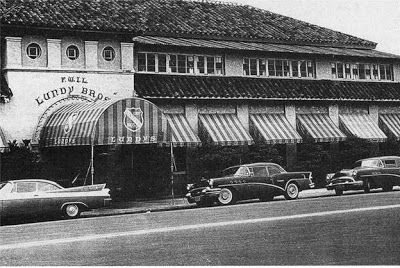Crain’s: Lundy’s Better Off As A Grocery Store?

Is the landmarked Lundy’s building better off as a grocery store? That’s the way Crain’s New York makes it sound.
An article published over the weekend takes a look at Cherry Hill Gourmet Market nearly a year after its grand opening. What they found is a thriving business that they say locals need more than another restaurant. And maybe they’re right, which could have powerful implications on the Sheepshead Bay Special Zoning District, the law that determines what kind of businesses can operate on the Emmons Avenue waterfront.
Here are the relevant excerpts from Crain’s:
After the death of the last of the original owners in 1976, the two-story, Mediterranean-style building with its red-tile roof stood empty for nearly 20 years until a second Lundy’s opened. It folded six years later, and since then, the neighborhood’s most famous address has been an increasingly shabby graveyard for a succession of businesses—a surprising number of them failing even before opening day.
…
The bottom line is that today’s Sheepshead Bay doesn’t need a 2,000-seat restaurant as much as a good high-end grocery store like Cherry Hill. What’s more, the market has helped revive a local landmark.
…
Even from a distance, the market contrasts with the other ground-floor tenants in the building. Tattered awnings hang over a Japanese restaurant and a small café, for example, and both have cracked windowpanes. In contrast, Cherry Hill boasts bright-red awnings and well-polished glass. Inside, it even pays homage to its predecessor with framed pictures of the original Lundy’s that hang among clay cherry blossoms made by a local ceramic artist.
Pulling off that transformation took many months of work for owner David Isaev, who points out that he had to overcome a reluctant landlord, a host of local skeptics, and the city’s vast bureaucracy, which hit him with no less than 46 stop-work orders.
“I was in war in Israel and saw nothing like this,” says the former Israeli army soldier.
As readers of Sheepshead Bites remember, the opening of Cherry Hill Gourmet Market was mired in controversy, as local leaders rallied to slam the construction as contrary to zoning. They said Cherry Hill’s owners misled the city by submitting plans that showed the majority of floor space being used for a restaurant (a requirement in accordance with the Sheepshead Bay Special Zoning District), with an accessory market. In reality, leaders said, the ratio was reversed and the market dominated. A Stop Work Order remains on the property that prevents Cherry Hill’s owners from developing the upper level, slated to be the restaurant.
The other side of the debate, though, sounded a lot like this Crain’s article. Better to see the building used and a business thrive than for a landmark to go derelict, they reasoned. And apparently business has been good. The existence of a thriving tenant in the building’s largest unit has freed up funds for them to renovate the former hotel section behind the building. It was recently reported that they’re seeking a seafood restaurant and a steakhouse to occupy the space.
But, it’s true, there is some magic lost when considering the Lundy’s building, frequently considered the anchor of Sheepshead Bay’s waterfront. That we can’t pack that building with restaurants and cafes and waterfront-related shops seems to prove Sheepshead Bay will never have the feel of an upper-crust Long Island waterfront town.
But is that so bad? Those places are hollow shells, tributes to artificiality and kitsch (ever been to Freeport’s Nautical Mile?). They’re usually filled with second-homes that sit empty nine months of the year. Sheepshead Bay, though, has got that “lived in” feel, buzzing all year long as residents shuttle to-and-fro. It’s organic, and it’s that authenticity that makes an attempt to force character upon our neighborhood with pre-determined businesses that makes it fail.
That’s not to say Cherry Hill Gourmet Market is “needed” in Sheepshead Bay. But it did spring up organically, and if it fails it will do that organically, too. Unless, of course, the continued hindrance of a “special zoning” contributes to their demise, a possibility as they’re denied usage of significant floor space.
Which raises the question: Is the tool the city created to foster waterfront businesses in Sheepshead Bay more likely to contribute to the demise of successful businesses along Emmons Avenue?
That’d be a terrible irony, and it’s time to start debating a reform to the waterfront’s zoning regulations.




